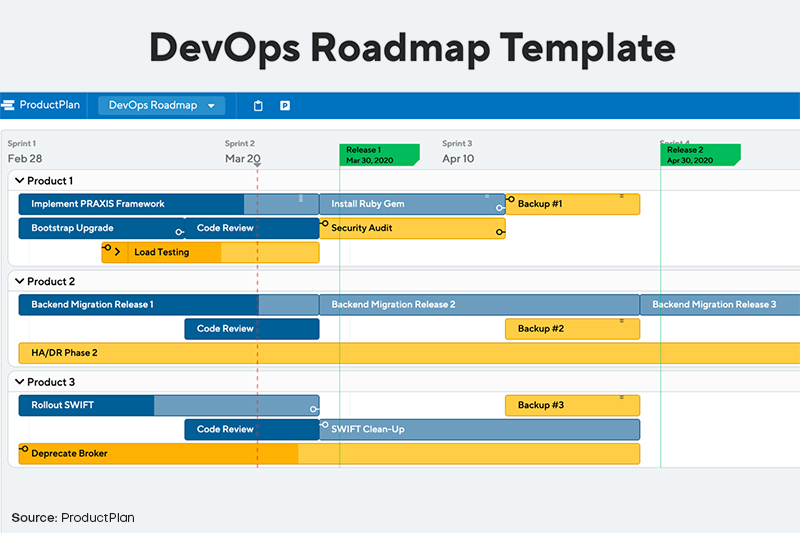A DevOps roadmap is a thorough visual overview that describes the methods and steps for accomplishing a company’s DevOps objectives and acts as a manual for implementing effective DevOps approaches. This article outlines the necessary components and steps to create a successful DevOps blueprint in 2022.
To raise the standard, some companies are painstakingly enhancing their delivery methods. But how can they do that in a better way? By maintaining a DevOps mindset. When deploying DevOps, companies’ main challenge is figuring out where to start. Despite gaining pounds of recognition, DevOps adoption is being hampered by a lack of implementation skills for faster software development and operations. To reap the benefits of the change, it becomes essential to ensure everyone in the company is ready to accept it.
A well-thought-out DevOps strategy is required if you are unsure of where to begin or how to proceed. This strategy, also known as a DevOps roadmap, aids in implementing an agile, continuous delivery approach in your business. This article will discuss the main components needed to create a DevOps roadmap and the critical processes to chalk out the strategy.
What is DevOps?
There are apparently several definitions of DevOps. To deploy code to production environments faster in a repetitive and automated manner, a technique is applied that guarantees a continuous sync between development and operation teams. This technique here is known as DevOps.
As AWS defined in simpler terms – DevOps is the combination of cultural philosophies, practices, and tools that improves an organization’s capacity to deliver applications and services at high velocity: products evolve and improve more quickly than they would in organizations using conventional software development and infrastructure management processes. As a result of the speed, organizations can provide better customer service and engage in more profitable market competition.

A roadmap can be extremely helpful for a DevOps team, just like in any other process in a software lifecycle, particularly when it is the team’s debut utilizing the method. By developing and using a DevOps roadmap for both development and operation divisions, companies can ensure a sync between the two. This constant harmony between the two teams ultimately draws success towards product goals.
Why you need a DevOps roadmap – top benefits
A roadmap serves as a pictorial representation of your intentions, prioritization, and product strategy for all parties involved in the software development cycle. Its primary job is to bring together cross-functional teams and bind them to a common goal. Of course, the team leads and management decide what gets into the product, how important a step is, and whether or not a certain part fits on the roadmap. But the precise format of a roadmap is still unknown. Before learning how to make one on our own, let’s first examine the benefits that a roadmap could provide. The top three benefits are:
- It serves as a thorough manual for stakeholders to comprehend the procedure
- Repeatedly enhances products and their functions
- DevOps teams coordinate to handle agendas and responsibilities
Implementing a DevOps Roadmap

A DevOps roadmap looks like any other one, which is helpful for individuals unfamiliar with the DevOps process. It is meant to be simple and understandable to everyone. Thus, a DevOps roadmap should have the following components:
- Lanes
Important groups are divided into lanes based on their responsibilities. These lanes are built on work divisions and reflect things like campaigns, teams, and product roles.
- Containers
On a roadmap, containers stand-in for the most crucial components. Use containers to draw attention to various activities on your roadmap, including projects, categories, and subjects.
- Bars
The meticulously prepared and placed key components are represented by bars underneath the appropriate containers. These are the initiatives that will be connected to the main idea of your strategy.
- Timelines
Ignore giving due dates or deadlines to elements in your roadmap. Dates shouldn’t be shown until the launch of your product coincides with the beginning of a crucial phase in your project. It’s better to focus on the work strategy rather than the deadlines.
- Legends
The legend will explain which color corresponds to the category without the viewer needing to dig anymore. The hues represent the urgency or fulfillment level of a product.
- Completion percentage
The status of any impending goals, projects, or initiatives on your team’s calendar should be shown on a roadmap, which should always be current. Any stakeholder may easily assess the status of a job by clicking over the indicator.
- Tags
Anybody browsing the roadmap may quickly discover pertinent tasks by using tags. A project team member may use the UX Design tag to find information on UX design.
Follow the steps to build a DevOps roadmap
Determine the roadmap’s objectives by understanding the organizational requirements
Start with the first step while planning to create a roadmap. Meet with your team and review the project’s main goal and the outcomes you hope to achieve. Planning beforehand can help you integrate the materials in the plan and choose the course of your path. Everyone will know what to do next if your goals are clear, making the route more accessible.
Ask the development and operation teams to review
A DevOps roadmap has a lot of value since it aids both teams in maintaining alignment and focusing on the efforts that influence one another’s work. You must, however, ensure both teams have access to the roadmap to enjoy its benefits. This will eventually enhance collaboration and efficiency between development and operations.
Giving each of these stakeholders access to your DevOps plan at any moment is the best way. They may keep track of their deadlines and check in to see what the other side is sending high-priority tasks their way.
Maintain focus and adhere to timelines
A company’s blueprint and a DevOps roadmap are comparable in many aspects. It is different, though, regarding how long the plan will last. A DevOps roadmap must be developed for a shorter period. Three months is supposedly a perfect timeline.
By focusing and taking little steps at first, you can maximize the potential of your DevOps roadmap. The highest priority initiatives and categories should guide the development and operations teams. Any more time spent can result in a disorganized and unclear roadmap.
Include graphic components to help others better grasp your roadmap
Instead of only boring textual representation, it’s a fantastic approach to interestingly conveying activities. Visual elements are easier to comprehend and pleasing to the eyes. It makes important information clear and simple to understand. Companies are completely free and flexible to experiment with various aesthetics in a roadmap. Use containers, themes, bars, color-coded labels, tags, etc., as examples.
Verify the effectiveness of your road map
You have a lot of alternatives, thanks to your DevOps roadmap. Encourage your team to actively review the workflow to ensure they are moving in the right direction. You may also see how well-coordinated your development and operation teams are now compared to previously. Another technique to assess the effectiveness of your plan is to look at the goals and their status.
Frequently update your roadmap
Finally, your team’s success will depend on how current and accurate your DevOps roadmap is regarding your business’s actual conditions.
You should thus assign yourself the task of regularly checking in with the roadmap. Ensure that the item matches the most recent strategic planning, objectives, budget, resource levels, etc., for your DevOps team. You should update your DevOps roadmap as soon as one of these facts changes. If not, your team can unintentionally invest time and resources in an old strategy.
Conclusion
Avoid adopting DevOps without first developing a roadmap if you intend to. Developing a roadmap can simply double the results of your efforts. This is a really effective solution that helps you keep your attention on your DevOps goals and enhance team cooperation to keep everyone on the same page.

